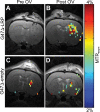Science to Practice: Monitoring Oncolytic Virus Therapy with Chemical Exchange Saturation Transfer MR Imaging--Wishful Thinking?
- PMID: 25997128
- PMCID: PMC4450909
- DOI: 10.1148/radiol.2015150537
Science to Practice: Monitoring Oncolytic Virus Therapy with Chemical Exchange Saturation Transfer MR Imaging--Wishful Thinking?
Abstract
Farrar et al demonstrate that modifying an oncolytic virus (OV) so that it produces excess protein when it infects a cancer cell is a process that can be detected both in vitro and in vivo in infected cancer cells by using chemical exchange saturation transfer (CEST) magnetic resonance (MR) imaging. The effect is at the limits of MR imaging detection (approximately 1%), but experience with functional MR imaging of the brain, with comparably small effects, should give pause to anyone who immediately writes this observation off as an exercise in wishful thinking. OVs are improving in their specificity, virulence, and ability to induce immune responses. Now, they have been modified to express proteins that are detectable with CEST MR imaging early after delivery into a tumor. This is clearly a surprising and hopeful development in the long road of OVs from the laboratory to the clinic.
Comment on
-
Establishing the Lysine-rich Protein CEST Reporter Gene as a CEST MR Imaging Detector for Oncolytic Virotherapy.Radiology. 2015 Jun;275(3):746-54. doi: 10.1148/radiol.14140251. Epub 2015 Feb 13. Radiology. 2015. PMID: 25686366 Free PMC article.
References
-
- Lichty BD, Breitbach CJ, Stojdl DF, Bell JC. Going viral with cancer immunotherapy. Nat Rev Cancer 2014;14(8):559–567. - PubMed
Publication types
MeSH terms
Substances
LinkOut - more resources
Full Text Sources
Other Literature Sources
Medical


